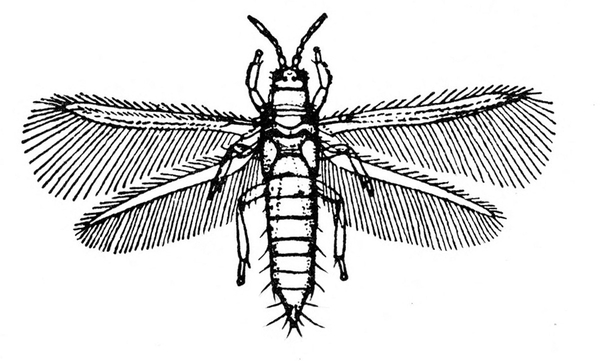The onion thrips and seedcorn maggot are essentially the only damaging onion insect pests in North Carolina. Onion thrips feed on onion leaves and flowers, whereas seedcorn maggots feed on and in onion bulbs.
- Onion thrips—The adult has a pale-yellow to dark-brown body slightly less than 1/16 inch in length and two pairs of narrow, fringed wings (Figure 1). Adults and larvae cause silvery blotches or scratch-like markings on leaves. Some infested leaves become distorted and curl upward.
- Seedcorn maggot—This legless, white to yellow-white maggot grows up to 1/4 inch long and has a tapered head (Figure 2). It feeds underground in bulbs, causing leaves to yellow and die and ruining the bulb. The onion maggot also occurs in North Carolina but poses a severe problem only in the northern states. Onion and seedcorn maggots cause the same type of damage, and the maggots are virtually indistinguishable in the field. (For more information about seedcorn maggots, see “Pests of Beans and Peas.”)
Onion Thrips
Thrips tabaci Lindeman, Thripidae, THYSANOPTERA
Description
Adult—Pale yellow to dark brown in color, the onion thrips adult is slightly less than 1/16 inch long. Its two pairs of narrow wings are fringed with long hairs (Figure 3A–C).
Egg—Each very small, milky-white, bean-shaped egg is inserted into a leaf.
Larvae—Larvae are spindle-shaped. First-stage larvae are less that 1/32 inch long, white, and wingless. Second-stage larvae also lack wings and may be green or yellow with red eyes and about the same length as adults (Figure 3A–C).
Prepupa and Pupa—These two stages resemble larvae in shape but show the beginnings of developing wings. The prepupa has short wing pads, and the pupa has longer ones. The pupa remains motionless unless disturbed.
Biology
Distribution—Onion thrips occur throughout the vegetable-producing areas of the United States and Canada.
Host Plants—Besides onion, garlic, and related plants, onion thrips injure cabbage, cauliflower, parsley, cucumber, melon, pumpkin, squash, kale, turnip, tomato, lettuce, bean, beet, pea, celery, blackberry, strawberry, and virtually all other vegetable and truck crops. Although potato, sweetpotato, and mustard are hosts, they are seldom injured severely. Greenhouse-grown flowers, cucumbers, and tomatoes are damaged frequently. Many grasses and weeds also harbor this species of thrips.
Damage—Adults and larvae rasp the tender parts of central leaves and terminal buds with their sharp mouthparts, inject saliva, and feed on escaping juices. Leaves develop silvery blotches or scratch-like markings. Some leaves become distorted and curl upward.
Light thrips infestations tend to delay plant growth and retard maturity. Heavy infestations may kill terminal buds or entire plants. Onion leaves become curled, crinkled, and twisted; growth stops; and plants die. When terminal buds on other types of crops are damaged, abnormal branching patterns result. Injury to plants is always more severe under hot, dry conditions.
Life History—All stages spend winters in sheltered areas of plants, such as remnants of onion plants left in the field or in crowns of alfalfa and clover. In spring, feeding and growth resume, and adults fly to suitable host plants. A female thrips produces 10 to 100 eggs that she inserts singly into tender leaf tissue. Eggs hatch four to ten days later. The larvae feed on leaves for about five days before entering the soil to molt into prepupae and then pupae. About four days later, new adults molt from the pupal stage and emerge from the soil to feed and lay eggs on tender plant foliage. Although adults are weak flyers, they are capable of flying from plant to plant and may be carried long distances by wind. Probably five to eight generations occur each year in North Carolina.
Control
Good cultural practices can suppress onion thrips populations. Destroying volunteer plants and crop residue after harvest eliminates many favorable overwintering sites. Because onion thrips populations build up rapidly on cucurbits, crucifers, and strawberries, these crops should not be planted near or rotated with onions.
Young onions being grown for bulbs should be sprayed once the thrips population reaches 10 thrips per plant. Onions grown for seed may need spraying only after plants begin to bloom. Tap the seedhead onto a pale, stiff surface to check for thrips. If at least three thrips fall out, it is likely that 20 to 30 more are still inside; in this case, apply an insecticide that is harmless to pollinating bees late in the evening. For specific recommendations, consult the North Carolina Agricultural Chemicals Manual.
Other Resources
Onion Thrips
Chittenden, F. H. Control of the Onion Thrips. Farmers' Bulletin 1007. USDA, 1919.
Wilcox, J., and F. H. Shirck. The Onion Thrips: How to Control It. Leaflet 372. USDA, 1960.
Publication date: June 12, 2024
AG-295
Other Publications in Insect and Related Pests of Vegetables
N.C. Cooperative Extension prohibits discrimination and harassment regardless of age, color, disability, family and marital status, gender identity, national origin, political beliefs, race, religion, sex (including pregnancy), sexual orientation and veteran status.



